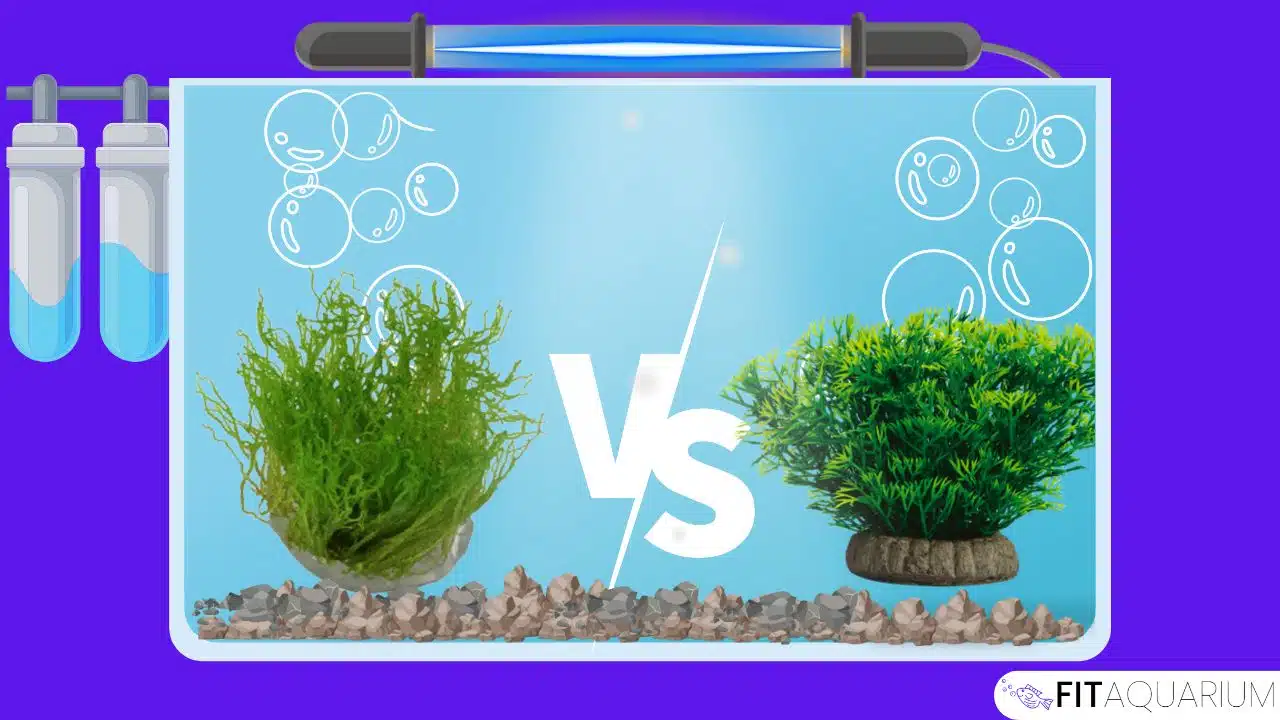A thriving patch of Flame Moss (Taxiphyllum sp.) can truly elevate your aquarium’s aesthetic. Its vibrant green texture and unique, flame-like form create a natural and calming atmosphere. However, achieving this lush growth requires proper care.
Flame moss, like any living organism, has specific needs for water quality, lighting, and CO2. By understanding these requirements, you can cultivate healthy, vibrant flame moss that not only enhances the beauty of your tank but also provides hiding spots for fish fry and helps maintain good water quality.
For those seeking a comprehensive guide to nurturing this popular aquarium plant, look no further. I’ve spent years cultivating flame moss in various setups, and in this article, I’ll share the key insights I’ve gained to ensure your flame moss flourishes. Dive in to discover the secrets to achieving a truly stunning display of flame moss in your aquarium.
Table of Contents
Basic Stats for Flame Moss
| Property | Value |
|---|---|
| Kingdom | Plantae |
| Family | Hypnaceae |
| Order | Hypnales |
| Genus | Taxiphyllum |
| Scientific Name | Taxiphyllum sp |
| Color | Vivid Green |
| Category | Freshwater Plants |
| Care Demand | Easy (Minimal to Moderate Care Required) |
| Growth Rate | Slow to Moderate |
| Maximum Size | Naturally 8 inches, however in a tank they often cap at 3 inches |
| pH | pH6 to pH8 |
| Temperature | 54°F to 86°F (12°-30° C) |
| Carbon Dioxide | A steady supply is not necessary but recommended as it provides a more colorful appearance of the flame moss |
| Lighting Setup | Low to Medium (for 8 to 10 hours a day) |
| Propagation | Cut and Rip |
| Tank Location | Must be far from direct sunlight and UV-emitting light sources |
| Placement in Aquarium | foreground /mid-ground plant / could be anchored to rocks and driftwood too. |
| Experience Level Needed | One can go with zero experience too (Recommended for both beginners and experts due to the least care level) |
![Flame Moss Care: A Beginner'S Guide To An Elegant Aquarium[2023] Flame moss quick stats](https://fitaquarium.com/wp-content/uploads/2023/02/Flame-Moss-Quick-Stats.webp)
Overview
Flame moss Taxiphyllum sp. has achieved universal praise and has become popular despite being found recently. Its attractive and eye-catching appearance includes an eye-comforting green tone that will make your aquarium look like a park and shoots that grow in vertical spirals look like a burning flame, just like the name.
Flame moss grows easily in a variety of aquarium environments, making it ideal for any aquarist. This moss can grow anywhere; no particular substrate or hardscape is required. Just like other mosses, the roots of flame moss grow while sticking to a surface.
Although scientists haven’t classified the flame moss as an individual species, we know it belongs to the Taxiphyllum genus, so we use the name species affix (sp.) to indicate this.
Flame moss reaches heights of 6 to 8 inches in its natural habitat. However, in a tank environment or aquarium, they often won’t grow larger than 3 inches, which is fine because it looks great in a glass tank.
![Flame Moss Care: A Beginner'S Guide To An Elegant Aquarium[2023] Flame moss structure - flame shaped](https://fitaquarium.com/wp-content/uploads/2023/02/Flame-Moss-Structure.webp)
In markets, flame moss could be purchased as a small loose portion, approx. 2″ x 2″ in size which is perfect for attaching with rocks, driftwood, and stones used for aquariums. I often used to attach flame moss with driftwood in my fish tank.
Flame Moss
![Flame Moss Care: A Beginner'S Guide To An Elegant Aquarium[2023] Flame moss product](https://fitaquarium.com/wp-content/uploads/2022/12/Flame-Moss-Product.png)
- Slow growth Rate
- Less Maintenance
- Easy to Care
Disclaimer: The images used for products are fetched from Amazon. All rights reserved to Amazon
Tank Requirements
Flame moss can be grown in any tank, regardless of size, and you can propagate it as much as you need to because, in an aquarium, it typically reaches a height of 3 to 4 inches in a vertical spiral. The floor of the aquarium looks like a flame moss carpet when growing at the bottom of the aquarium side by side covering the whole basin.
Water Specifications
For maximum results, the aquarium water should possess these qualities:
Water Temperature Ranges:
12°C to 30°C (54°F to 86°F)
Ideal pH range:
The optimum pH Level for flame moss to flourish would be 6 to 8.
Degrees of General Hardness (dGH):
30 degrees or higher (500 ppm)
Aquarium moss usually grows faster in slightly more acidic water. To grow flame moss, keep above mentioned properties well maintained as the growth rate is directly proportional to care.
Required Lighting Conditions
You don’t need powerful lights or extraordinary luminance because flam moss can photosynthesize in low light. You must have to avoid powerful lights because they could damage your flame moss by burning them. The best option is a set of planted aquarium LED lights, which are flame moss friendly.
Fertilizers & Substrates Required for Flame Moss
For the growth of flame moss, all kinds of substrates are beneficial. As long as flame moss has access to the nutrients needed for its growth, its root structure will allow it to grow almost anywhere.
This plant usually struggles to accumulate the substrate, so you’ll have to make it there by yourself. In my opinion, using cotton thread for this could get the job done because it will gradually disintegrate when the plant’s rhizoids, or “feet,” can cling to the surface.
![Flame Moss Care: A Beginner'S Guide To An Elegant Aquarium[2023] Tank requirements for flame moss](https://fitaquarium.com/wp-content/uploads/2023/02/Tank-Requirements-for-Flame-Moss.webp)
Tank Mates for Flame Moss
Flame mosses are capable of adjusting themselves along with all kinds of aquatic life except for algae. As algae take all the essential components of the environment in which they grow if they grow within the tank containing flame mosses, it will also affect beautiful flame plants by taking all the essential components like oxygen, carbon dioxide, and minerals from the tank and eventually, your flame moss will have to suffer death.
Note: You can put some algae eaters (like amano shrimp, nerite snails etc) in there to protect your flame mosses.
Nerite Snails, Reticulated Hillstream Loach, Cherry Shrimp, Bristlenose Plecostomus, Siamese Algae Eater, Amano Shrimp, or Florida Flagfish can help you out as these all are algae eaters for the freshwater fish aquariums and also will enhance the sightseeing and natural beauty of your tank.
These species use the flame moss plant as a shelter and eat the biofilm layer that is used to build on the moss. These creatures will also be advantageous for the nitrogen cycle within the tank.
How to Plant Flame Moss?
Although this is an aquatic plant, it can also survive even with low exposure to water. It can be placed pretty much anywhere in the tank and will grow whether you attach it to the substrate or leave it floating on the surface.
For nutrition, water the plant frequently if you want it to be grown out of water. Otherwise, it will take water and oxygen by itself if you allow it to grow within the water of the tank. Flame moss has an undeveloped root system. Thanks to its many rhizoids, this moss receives nutrients from the soil and water.
Flame Moss Care and Maintenance
As I have already discussed flame mosses require very little but particular care to thrive in a well-kept aquarium and are significantly simple to maintain.
It is important to keep it away from UV rays and direct sunlight because exposure to direct light or ultraviolet radiations or too much light from artificial aquarium lamps might burn the freshwater plant which you must not want to happen. If you are fond of brightly illuminated aquariums, then, you must go with java moss, a related plant that can endure stronger light.
Along with this, you must have to take care that no algae grows in your tank as algae are harmful to the propagation of this plant hence properly maintained aquarium tanks should be first priority.
Propagation of Flame Moss
With the development growth of flame mosses, you can use scissors to harvest them into smaller pieces and plant these separate bushes anywhere in the fish tank as per your own will and witness the flame moss propagation.
The baby flame mosses will grow most likely as parents grow and decorate your tank in a very astonishing way. To propagate flame moss in large quantities, you must repeat this procedure (Some aquarists dislike it for its slow growth rate).
Uses of Flame Moss in Freshwater Aquariums
Like other mosses, flame mosses are quite flexible, easy to handle, and may be utilized in a variety of ways to decorate your aquatic tank.
You can adorn the walls of your aquarium or carpet it with layers of flame mosses on the substrate and the interior sides of the tank. The plant will grow the same in any setting and will provide a natural environment for your pet fish.
Flame mosses are also environmentally friendly as the small animals that live there, can utilize them for food and shelter. Although it doesn’t offer many chemical benefits to an aquarium it has some significant impacts on aquatic life in your freshwater fish aquariums. Your fish and other marine life will enjoy the company of this plant in the tank.
The dark green complexion of flame moss plants looks very attractive to fish in aquarium tank
Benefits of Flame Moss
Improving Water Quality
Flame mosses are capable of absorbing extra nutrients and minerals from the tank’s water thus their tank mates enjoy a healthy environment.
Increasing Oxygen Level
As flame moss is a plant and in the process of photosynthesis, it absorbs CO2 and releases Oxygen which is necessary for supporting aquatic life.
Promoting Biodiversity in Aquariums
Flame moss can boost the biodiversity within the aquatic tank because it provides a habitat and food source for various microorganisms in the tank including insects and larvae.
Low Maintenance
Flame moss does not require a properly maintained aquarium tank or proper care like trimming and pruning hence becomes a low-maintenance plant leading to time-saving for enthusiasts.
Improving Water Flow
Unlike other aquarium mosses, Flame moss does not grow horizontally in all directions, instead, it grows vertically upward having a dense growth pattern that is beneficial for water flow and circulation in the aquarium, providing a more stable environment for fish.
Enhancing Natural Beauty
Bright green flame moss provides a lush natural-looking underwater landscape enhancing the visual appeal of any aquarium tank. Must ensure water is filtered and pH level is maintained regularly.
![Flame Moss Care: A Beginner'S Guide To An Elegant Aquarium[2023] Benefits of flame moss](https://fitaquarium.com/wp-content/uploads/2023/02/Benefits-of-Flame-Moss.webp)
Common Problems for having Flame Moss and How to Resolve them
Flame Moss Dying or Turning Yellow
Poor water quality and inadequate nutrients can lead to this situation. Ensure the tank water is filtered and the pH level is within the bearable limits for flame moss.
Stunted Growth
If the water temperature and lightning system are not suitable, you may encounter this problem. To avoid this, regularly check and adjust the temperature and lighting to match the optimal conditions for flame moss growth.
Shriveled Appearance & Overgrowth
Due to dehydration (if the water flow is too low or if the flame moss plant is not being misted frequently enough), this problem can occur. Mist your flame moss plant and increase water flow to tackle this.
If your flame moss is growing too rapidly, trim it regularly but carefully so that healthy parts won’t be damaged.
![Flame Moss Care: A Beginner'S Guide To An Elegant Aquarium[2023] Flame moss diseases and their possible solutions](https://fitaquarium.com/wp-content/uploads/2023/02/Flame-Moss-Diseases.webp)
Comparison with other mosses
With Java Moss
In its comparison with Java Moss Taxiphyllum Barbieri, flame moss keeps its growth vertically upward while java moss tends to grow horizontally in all directions.
In terms of growth pace, flaming moss grows more slowly than java moss. It eventually determines that java moss requires more trimming and cutting in comparison.
Talking about the environmental requirements, both aquarium mosses require nearly identical tank conditions.
You May Also Like Reading: Java Moss Ball Vs Marimo: A Comprehensive Comparison
Flame Moss Care Infographic
I have also designed a simple yet helpful infographic on Flame moss care. It would be enough for you to save on your mobile instead of reading the whole article again.
![Flame Moss Care: A Beginner'S Guide To An Elegant Aquarium[2023] Flame moss care infographic by fitaquarium](https://fitaquarium.com/wp-content/uploads/2023/02/Flame-Moss-Care-Infographic-by-FitAquarium.webp)
Conclusion
Flame moss is a very resilient plant having the ability to bloom in a variety of environments, and is easy to cope with. No extra fertilizers are needed for the growth of this plant. CO2 is required in very low amounts for its fast and healthy growth. Yet planting flame moss is a minor challenge.
The final words would definitely be for having flame moss in your aquarium.
Disclaimer: As an Amazon Associate, we earn from qualifying purchases (with no extra costs to you)
Frequently Asked Questions
Here are some of the frequently asked questions about Flame Moss
-
Is flame moss fast growing?
No, Flame moss is actually considered to be slow growing aquatic moss. This could be beneficial for aquascapers though, as it gives more control over plant growth and easy to achieve desired aesthetics with less trimming.
-
How tall does flame moss grow?
Flame Moss (Taxiphyllum sp.) can grow to a height of 6 to 8 inches in the natural habitat, but only 3 inches in an aquarium. Nonetheless, it appears to be rather lovely. Its shoots can reach a length of 6-8 inches horizontally. It grows slowly and takes around 4 weeks to attach itself to the surface.
-
Will Flame moss spread?
Flame moss does, in fact, grow over time. Yet, when compared to other aquatic mosses such as java moss or Christmas moss, it grows slowly. You may accelerate its growth by providing proper lighting and additional fertilizers and CO2.
-
Can Flame Moss grow on land?
No, flame moss is a semi-aquatic or aquatic moss that grows predominantly underwater. It is often used in humid aquariums and terrariums. While it may withstand brief periods of air exposure, it will not flourish or develop on land in the same way that it does when submerged in water.

![Flame Moss Care: A Beginner'S Guide To An Elegant Aquarium[2023] Flame moss care](https://fitaquarium.com/wp-content/uploads/2023/02/Flame-Moss-Care.webp)



